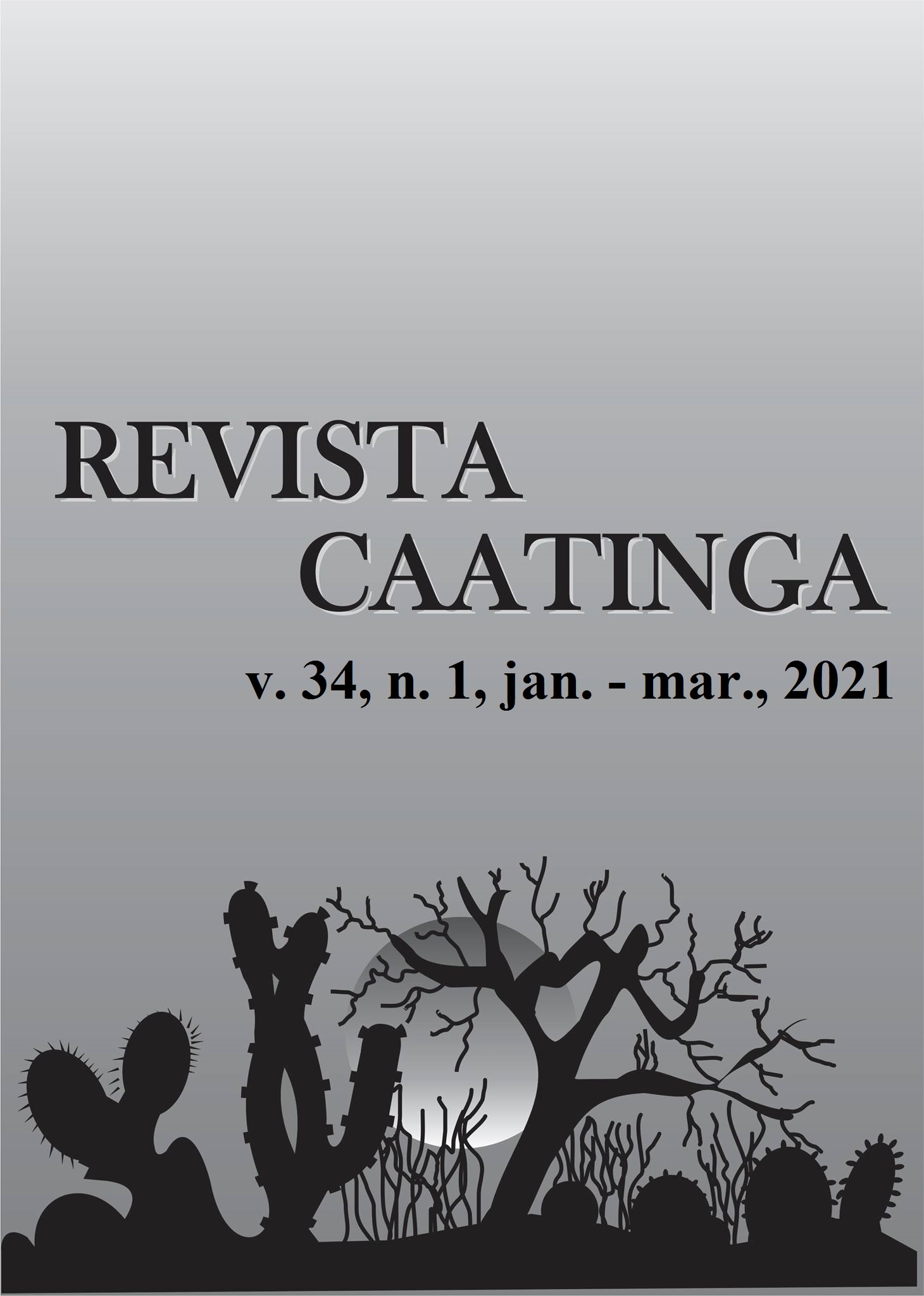DROUGHT TOLERANCE IN INTERVARIETAL MAIZE HYBRIDS
DOI:
https://doi.org/10.1590/1983-21252021v34n109rcKeywords:
Water deficit. GGE Biplot. Genotype x environment interaction.Abstract
In the period of planting of second-season maize, there is high climatic instability with greater probability of occurrence of water deficit. This is one of the factors that most cause reduction in maize grain yield. In this context, the aim was to identify stable, irrigation-responsive and drought-tolerant maize genotypes. The experiments were conducted in Mococa / SP and Tatuí / SP, at Instituto Agronômico, in two assays, one under full irrigation conditions and the other under water stress. The experimental design was randomized blocks with 3 replicates. Male flowering, female flowering, plant height, ear height, hectoliter weight, one hundred grain weight and grain yield were evaluated. Joint analysis of variance and stability analysis were performed by the GGEBiplot method. Significant genotype and site effects were observed for all traits. Significant effects of genotype x site interaction were found for all traits except ear height and male flowering. The characteristics most affected by water deficit were male flowering, plant and ear heights and grain yield. Genotypes F2 BM709 x PopTol 2, IAC 46 x PopTol 2, F2 30K75 x PopTol 3 and F2 BM709 x PopTol 3 are considered ideotypes because of their high grain yield, phenotypic plasticity and drought tolerance.
Downloads
References
AHMADIKHAH, A.; MARUFINIA, A. Effect of reduced plant height on drought tolerance in rice, 3. Biotech, 6: 1–9, 2016.
ANJUM, S. A. et al. Drought induced changes in growth, osmolyte accumulation and antioxidant metabolism of three maize hybrids. Frontiers in Plant Science, 8: 1-12, 2017.
BERNARDO, R. Breeding for quantitative traits in plants. 2. ed., Woodbury, Minn: Stemma Press, 2010. 400p.
CECCARELLI, S. Adaptation to low or high input cultivation. Euphytica, 92: 203-214, 1996.
DERERA, J.; TONGOONA, P.; VIVEK, B. S. Gene action controlling grain yield and secondary traits in southern African maize hybrids under drought and non-drought environments. Euphytica, 162: 411–422, 2008.
DURAES, F. O. M. et al. Fenotipagem associada à tolerância a seca em milho para uso em melhoramento, estudos genômicos e seleção assistida por marcadores. Sete Lagoas, MG: EMBRAPA, 2004, 17 p.
EDMEADES, G. O. Progress in achieving and delivering drought tolerance in maize - An Update. Ithaca, NY: ISAAA, 2013, 44 p.
FRUTOS, E.; GALINDO, M. P.; LEIVA, V. An interactive biplot implementation in R for modeling genotype-by-environment interaction. Stochastic Environmental Research and Risk Assessment, 28: 1629–1641, 2014.
GUIMARÃES, P. D. S. et al. Characterizing corn hybrids (Zea mays L.) for water shortage by principal components analysis. Maydica, 59: 72–79, 2014.
KARIMIZADEH, R. et al. GGE biplot analysis of yield stability in multi-environment trials of lentil genotypes under rainfed condition. Notulae Scientia Biologicae. 5:256-262, 2013
MADABULA, F. P. et al. Rice genotypes for drought tolerance: morphological and transcriptional evaluation of auxin-related genes. Bragantia, 75: 428- 434, 2016.
MELO, A. V. et al. Desempenho agronômico de genótipos de milho submetidos ao déficit hídrico no sul do estado do tocantins. Revista Brasileira de Milho e Sorgo, 17: 177-189, 2018.
MORENO, A.; LUMBRERAS, V.; PAGES, M. Drought tolerance in maize. Maydica, 50: 549-558, 2005.
PIAS, O. H. C. et al. Componentes de rendimento e produtividade de híbridos de milho em função de doses de NPK e de déficit hídrico em estádios fenológicos críticos. Revista de Ciências Agroveterinárias, 16: 422-432, 2017.
RIBAUT, J. M.et al. Drought tolerance in maize. In: BENNETZEN, J.L.; HAKE, S.C. (Eds.). Handbook of Maize: Its Biology. Nova York, NY. 2009, p. 311–314.
SCOTT, A. J.; KNOTT, M. A cluster analysis method for grouping means in the analysis of variance. Biometrics, 30: 507-512, 1974.
SCHLICHTING, A. F. et al. Desenvolvimento do milho submetido a doses de nitrogênio e tensões de água no solo. Irriga, 19: 598-611, 2014
SSERUMAGA, J. P. et al. Grain-yield stability among tropical maize hybrids derived from doubled-haploid inbred lines under random drought stress and optimum moisture conditions. Crop and Pasture Science, 69: 691–702, 2018.
TARDIEU, F.; SIMONNEAU, T.; MULLER, B. The physiological basis of drought tolerance in crop plants: a scenario-dependent probabilistic approach. Annual review of plant biology, 69: 733-759, 2018.
THORNTHWAITE, C. W. An approach toward a rational classification of climate. New York, NY, 1948, v. 38, n. 1, p. 55-94.
THORNTHWAITE, C. W.; MATHER, J. R. The water balance. Climatology, v. 8, n. 1, p. 104,1955.
TUBEROSA, R. Phenotyping for drought tolerance of crops in the genomics era. Frontiers in Physiology, 3: 1–26, 2012.
YAN, W. et al. Cultivar Evaluation and Mega-Environment Investigation Based on the GGE Biplot. Crop Science, 40: 597-605, 2000.
YAN, W. GGE Biplot vs. AMMI Graphs for Genotype-by-Environment Data Analysis. Journal of the India Society of Agricultural Statistics, 65: 181-193, 2011.
ZIYOMO, C.; BERNARDO, R. Drought tolerance in maize: Indirect selection through secondary traits versus genome wide selection. Crop Science, 53: 1269–1275, 2013.
ZHAO, J. et al. Shoot and root traits in drought tolerant maize (Zea mays L.) hybrids. Journal of Integrative Agriculture, 17: 1093-1105, 2018.
Downloads
Published
Issue
Section
License
Os Autores que publicam na Revista Caatinga concordam com os seguintes termos:
a) Os Autores mantêm os direitos autorais e concedem à revista o direito de primeira publicação, com o trabalho simultaneamente licenciado sob a Licença Creative Commons do tipo atribuição CC-BY, para todo o conteúdo do periódico, exceto onde estiver identificado, que permite o compartilhamento do trabalho com reconhecimento da autoria e publicação inicial nesta revista, sem fins comerciais.
b) Os Autores têm autorização para distribuição não-exclusiva da versão do trabalho publicada nesta revista (ex.: publicar em repositório institucional ou como capítulo de livro), com reconhecimento de autoria e publicação inicial nesta revista.
c) Os Autores têm permissão e são estimulados a publicar e distribuir seu trabalho online (ex.: em repositórios institucionais ou na sua página pessoal) a qualquer ponto antes ou durante o processo editorial, já que isso pode gerar alterações produtivas, bem como aumentar o impacto e a citação do trabalho publicado (Veja O Efeito do Acesso Livre).







